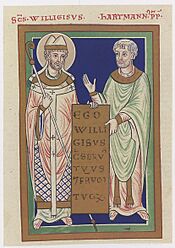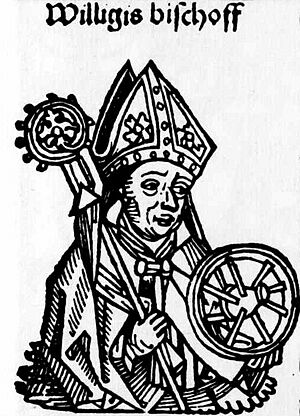Willigis facts for kids
Quick facts for kids SaintWilligis |
|
|---|---|

Saint Willigis and Provost Hartmann, 12th century depiction, Russian State Library
|
|
| Archbishop | |
| Born | c. 940 Schöningen, Saxony |
| Died | February 23, 1011 Mainz, Rhenish Franconia |
| Venerated in | Eastern Orthodox Church Roman Catholic Church |
| Feast | February 23 |
| Attributes | Wheel of Mainz |
| Patronage | Wheelwrights |
Willigis was a very important leader in the Middle Ages. He lived from about 940 to 1011 AD. He became the Archbishop of Mainz in 975 and held this powerful position until he died. He was also a top official, called the Archchancellor, in the Holy Roman Empire.
Contents
Life of Willigis
Early Life and Education
Willigis was born around 940 in a region called Duchy of Saxony. He might have been born in a town called Schöningen. His family were free peasants, which means they owned their land.
Willigis was a smart and capable young man. He received a good education for his time. Bishop Volkold of Meissen noticed his talents. The bishop then suggested Willigis work for Emperor Otto the Great.
Around 971, Willigis became the emperor's chancellor. This was a very important job. He helped Otto the Great for several years.
Becoming Archbishop
In 975, Emperor Otto II made Willigis the Archbishop of Mainz. This also made him the Archchancellor for Germany. Some people didn't like this because Willigis came from a humble background.
To show his authority, Willigis quickly got Pope Benedict VII to confirm his high rank. He was known for being a good speaker. He also wanted his clergy (church leaders) to be well-educated.
In March 975, he received the pallium from Pope Benedict VII. This was a special wool garment that showed his authority as an archbishop. In 976, Willigis likely consecrated the first Bishop of Prague, Thietmar. This meant the Prague diocese was under Willigis's control.
A Powerful Leader
In 983, at a big meeting called the Reichstag in Verona, Emperor Otto II gave Willigis a lot of land. This land was in the Rheingau region. This gift helped create the Prince-Bishopric of Mainz, which was a powerful church state.
When Emperor Otto II died, Willigis became a very important figure. He was the Primas Germaniae, meaning the top church leader in Germany. In December 983, he crowned Otto II's three-year-old son, Otto III, as King of the Romans. This happened in Aachen.
After Otto III's mother, Empress Theophanu, died in 991, Willigis became a guardian for the young king. This meant he was one of the people who ruled the empire. He shared this role with Otto III's grandmother, Adelaide of Italy. They ruled until Otto III was old enough in 994.
Working with Popes
In 996, Willigis traveled to Italy with King Otto III. They helped elect Pope Gregory V. This was against the wishes of some Roman nobles. Willigis was there for the Pope's consecration and a church meeting (synod).
At this meeting, Willigis strongly urged Bishop Adalbert of Prague to return to his diocese. Adalbert had left his church area twice because of conflicts with noble families. Pope Gregory V later sent decrees from another synod to Willigis. He called Willigis "his vicar," meaning his representative.
Willigis generally had good relations with Rome. However, there was a disagreement with Bishop Bernward of Hildesheim. They argued over who had control of a monastery called Gandersheim Abbey. The Pope eventually decided in favor of Hildesheim, even though Willigis disagreed at first.
Later Years and Legacy
Willigis was a mentor to Burchard, a smart and fair scholar. Emperor Otto III made Burchard the Bishop of Worms in 1000.
After Emperor Otto III died early, Willigis crowned Henry IV, the Duke of Bavaria, as King of the Romans. This happened in Mainz on June 7, 1002.
In 1007, Willigis led a church meeting (synod) in Frankfurt am Main. At this meeting, thirty-five bishops signed a document from Pope John XVIII. This document allowed the creation of the Diocese of Bamberg.
Even though Willigis was never officially made a saint, Roman Catholics remember him on February 23. This is the day he died in 1011. Some also celebrate him on April 18.
Willigis the Builder
Willigis worked hard to improve his diocese. He built bridges, constructed roads, and helped trade grow. In Mainz, he started building the huge Cathedral of Mainz.
He consecrated the cathedral on August 29, 1009. It was dedicated to St. Martin of Tours. Sadly, on the very same day, a fire destroyed it. Willigis immediately ordered it to be rebuilt.
Willigis also helped restore the old church of St. Victor. He built the church of St. Stephan in Mainz too. He built other churches in places like Brunnen and Seesbach. He cared a lot about religious communities. He greatly helped monasteries like St. Ferrutius, Disibodenberg, and Jechaburg.
Because the cathedral was still being rebuilt, Willigis was buried in the Church of St Stephan when he died.
See also
- Wheel of Mainz


